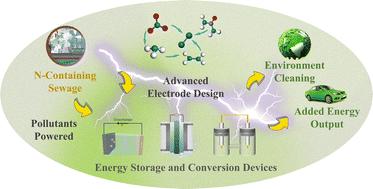当前位置:
X-MOL 学术
›
Chem. Soc. Rev.
›
论文详情
Our official English website, www.x-mol.net, welcomes your
feedback! (Note: you will need to create a separate account there.)
Electrodegradation of nitrogenous pollutants in sewage: from reaction fundamentals to energy valorization applications
Chemical Society Reviews ( IF 40.4 ) Pub Date : 2024-11-05 , DOI: 10.1039/d4cs00517a Ming-Lei Sun, Hao-Yu Wang, Yi Feng, Jin-Tao Ren, Lei Wang, Zhong-Yong Yuan
Chemical Society Reviews ( IF 40.4 ) Pub Date : 2024-11-05 , DOI: 10.1039/d4cs00517a Ming-Lei Sun, Hao-Yu Wang, Yi Feng, Jin-Tao Ren, Lei Wang, Zhong-Yong Yuan

|
The excessive accumulation of nitrogen pollutants (mainly nitrate, nitrite, ammonia nitrogen, hydrazine, and urea) in water bodies seriously disrupts the natural nitrogen cycle and poses a significant threat to human life and health. Electrolysis is considered a promising method to degrade these nitrogenous pollutants in sewage, with the advantages of high efficiency, wide generality, easy operability, retrievability, and environmental friendliness. For particular energy devices, including metal-nitrate batteries, direct fuel cells, and hybrid water electrolyzers, the realization of energy valorization from sewage purification processes (e.g., valuable chemical generation, electricity output, and hydrogen production) becomes feasible. Despite the progress in the research on pollutant electrodegradation, the development of electrocatalysts with high activity, stability, and selectivity for pollutant removal, coupled with corresponding energy devices, remains a challenge. This review comprehensively provides advanced insights into the electrodegradation processes of nitrogenous pollutants and relevant energy valorization strategies, focusing on the reaction mechanisms, activity descriptors, electrocatalyst design, and actuated electrodes and operation parameters of tailored energy conversion devices. A feasibility analysis of electrodegradation on real wastewater samples from the perspective of pollutant concentration, pollutant accumulation, and electrolyte effects is provided. Challenges and prospects for the future development of electrodegradation systems are also discussed in detail to bridge the gap between experimental trials and commercial applications.
中文翻译:

污水中含氮污染物的电降解:从反应基础到能源增值应用
氮污染物(主要是硝酸盐、亚硝酸盐、氨氮、肼和尿素)在水体中的过量积累严重破坏了自然氮循环,对人类生命健康构成重大威胁。电解法被认为是降解污水中这些含氮污染物的一种很有前途的方法,具有效率高、通用性广、易于操作、可回收、环境友好等优点。对于特定的能源设备,包括金属硝酸盐电池、直接燃料电池和混合水电解槽,从污水净化过程(例如有价值的化学品生产、电力输出和氢气生产)中实现能源价值化变得可行。尽管污染物电降解研究取得了进展,但开发具有高活性、稳定性和去除污染物选择性的电催化剂以及相应的能源器件仍然是一个挑战。本文全面提供了对含氮污染物电降解过程和相关能量增值策略的深入见解,重点介绍了反应机理、活性描述符、电催化剂设计以及定制能量转换装置的驱动电极和操作参数。从污染物浓度、污染物积累和电解质效应的角度对实际废水样品进行电降解的可行性分析。还详细讨论了电降解系统未来发展的挑战和前景,以弥合实验试验和商业应用之间的差距。
更新日期:2024-11-05
中文翻译:

污水中含氮污染物的电降解:从反应基础到能源增值应用
氮污染物(主要是硝酸盐、亚硝酸盐、氨氮、肼和尿素)在水体中的过量积累严重破坏了自然氮循环,对人类生命健康构成重大威胁。电解法被认为是降解污水中这些含氮污染物的一种很有前途的方法,具有效率高、通用性广、易于操作、可回收、环境友好等优点。对于特定的能源设备,包括金属硝酸盐电池、直接燃料电池和混合水电解槽,从污水净化过程(例如有价值的化学品生产、电力输出和氢气生产)中实现能源价值化变得可行。尽管污染物电降解研究取得了进展,但开发具有高活性、稳定性和去除污染物选择性的电催化剂以及相应的能源器件仍然是一个挑战。本文全面提供了对含氮污染物电降解过程和相关能量增值策略的深入见解,重点介绍了反应机理、活性描述符、电催化剂设计以及定制能量转换装置的驱动电极和操作参数。从污染物浓度、污染物积累和电解质效应的角度对实际废水样品进行电降解的可行性分析。还详细讨论了电降解系统未来发展的挑战和前景,以弥合实验试验和商业应用之间的差距。































 京公网安备 11010802027423号
京公网安备 11010802027423号